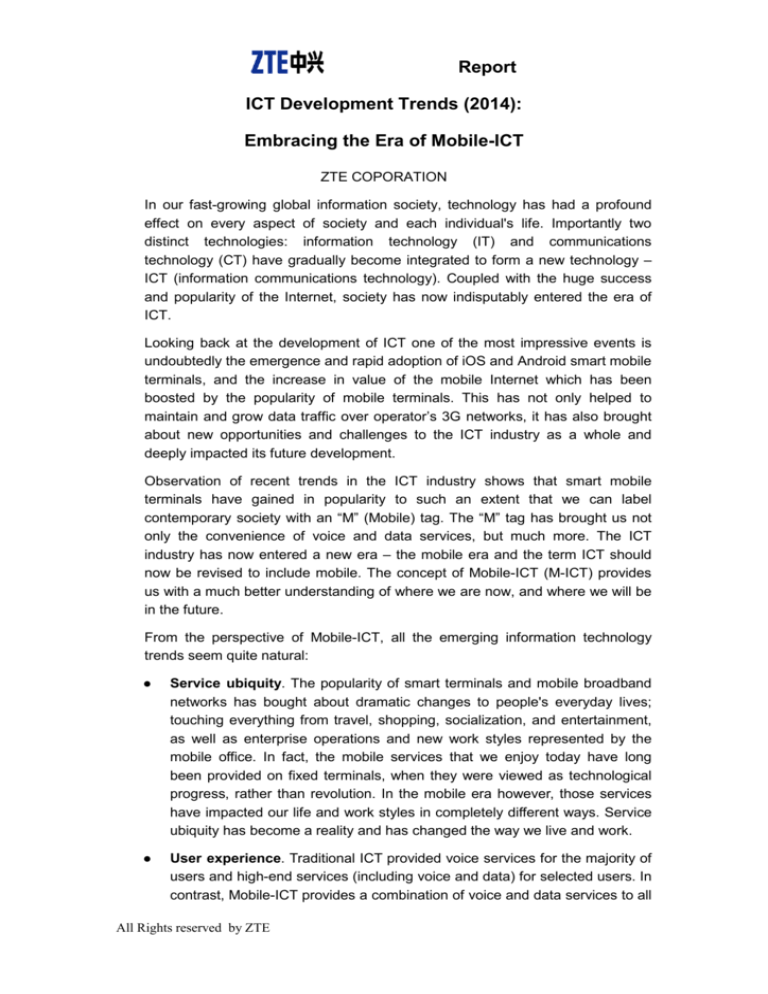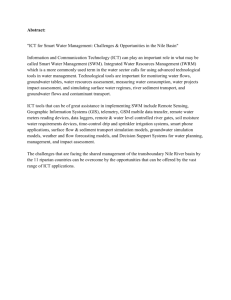
Report
ICT Development Trends (2014):
Embracing the Era of Mobile-ICT
ZTE COPORATION
In our fast-growing global information society, technology has had a profound
effect on every aspect of society and each individual's life. Importantly two
distinct technologies: information technology (IT) and communications
technology (CT) have gradually become integrated to form a new technology –
ICT (information communications technology). Coupled with the huge success
and popularity of the Internet, society has now indisputably entered the era of
ICT.
Looking back at the development of ICT one of the most impressive events is
undoubtedly the emergence and rapid adoption of iOS and Android smart mobile
terminals, and the increase in value of the mobile Internet which has been
boosted by the popularity of mobile terminals. This has not only helped to
maintain and grow data traffic over operator’s 3G networks, it has also brought
about new opportunities and challenges to the ICT industry as a whole and
deeply impacted its future development.
Observation of recent trends in the ICT industry shows that smart mobile
terminals have gained in popularity to such an extent that we can label
contemporary society with an “M” (Mobile) tag. The “M” tag has brought us not
only the convenience of voice and data services, but much more. The ICT
industry has now entered a new era – the mobile era and the term ICT should
now be revised to include mobile. The concept of Mobile-ICT (M-ICT) provides
us with a much better understanding of where we are now, and where we will be
in the future.
From the perspective of Mobile-ICT, all the emerging information technology
trends seem quite natural:
●
Service ubiquity. The popularity of smart terminals and mobile broadband
networks has bought about dramatic changes to people's everyday lives;
touching everything from travel, shopping, socialization, and entertainment,
as well as enterprise operations and new work styles represented by the
mobile office. In fact, the mobile services that we enjoy today have long
been provided on fixed terminals, when they were viewed as technological
progress, rather than revolution. In the mobile era however, those services
have impacted our life and work styles in completely different ways. Service
ubiquity has become a reality and has changed the way we live and work.
●
User experience. Traditional ICT provided voice services for the majority of
users and high-end services (including voice and data) for selected users. In
contrast, Mobile-ICT provides a combination of voice and data services to all
All Rights reserved by ZTE
Report
users almost ubiquitously. The performance of combined services cannot be
measured by traditional ICT product performance indicators but should
instead be evaluated by the user experience.
Service ubiquity and user experience will be key markers in the Mobile-ICT era.
Nevertheless, the traditional ICT industry will continue to develop rapidly, leading
to a new round of innovations in finance, transportation, energy, education,
healthcare and other industries. However, to better serve society, the industry
must continue to confront and solve many existing and new questions:
How to effectively invest in the IT infrastructure of enterprises while
satisfying their mobile working requirements?
How to continuously satisfy the core demand of increasing user experience
based on the vast number of subscribers?
How to design more reasonable innovative business models, so that all
parties in the industry, including mobile operators, can achieve fair economic
returns?
How to address the increasingly severe challenges on network security
when society is relying more and more on network services?
While developing the new technologies needed for the network evolution we
have considered the questions that confront the entire ICT industry and have
observed the following development trends:
Ⅰ. Seamless mobile access
Smartphones and smart pads are no longer alone in this revolution. The “lastmile” access technology, represented by WLAN, will gradually become the
mainstream wireless technology, providing access points that replace wireline
broadband access. In offices and in homes, on highways and railways, at
airports and on airplanes, wireless access technology that seamlessly integrates
3G/4G/WLAN will become prevalent in the next few years, providing flexible,
reliable and seamless wireless network access to users, by means of ever
higher bandwidths.
Ⅱ. Smarter, more flexible and wearable Mobile Devices
Smartphone CPUs have grown from dual core to quad core and even octa core.
The processing power of smart terminals is rapidly increasing, and wearable
devices such as smart glasses and smart watches have appeared on the
market, demonstrating a potential that is still hard to assess, but leaves plenty of
room for the imagination. The industry has progressed in a number of important
ways with flexible screens, flexible battery and other technologies, which create
more opportunities for smart terminals. The quick take-up of HTML5 is expected
All Rights reserved by ZTE
Report
to break the “walled garden” of APP stores, and web-based applications and
local applications will co-exist for a long period of time.
Ⅲ. Anytime, anywhere
In the era of Mobile-ICT, services will be available ubiquitously thanks to the
seamless access environment, increasingly strong and flexible smart terminals,
and cloud computing technology. Mobile office, information sharing,
socialization, electronic business, Internet finance and other services will be
accessible to users at anytime and anywhere, further facilitating our life and
improving our lifestyle with better experiences.
Ⅳ. Rapid growth of enterprise mobile applications
Broadband wireless access and the rapid development of smart terminals
provide convenient usage scenarios beyond the mobile office. Supported by a
rapidly progressing security technology and Internet-of-Things (IoT) technology,
enterprises will follow the trend of Mobile-ICT when deploying both critical
external services and core internal applications. Mobility will cover every aspect
of enterprise management and operation. This will significantly enhance
enterprise operations and production efficiency, and provide rich new
possibilities for ICT enterprises to profit from the mobile Internet.
Ⅴ. Scalable bandwidth
The flood of digital services requires that every layer of the network
infrastructure speeds up its own evolution; from the access layer to the core
layer, and from the wired network to the wireless network. At the core, it is the
demand for higher bandwidth that drives the evolution of backbone networks
towards 100G bearer networks and beyond. The transmission rate of wired
access networks, however, will remain one order higher than the rate of wireless
transmission. This imbalance in development will face a bottleneck sooner or
later. Only innovation can break the bottleneck to allow the bandwidth to match
Moore's Law and the capabilities of information processing. Such technology will
provide a connection for the smooth exchange of exponentially expanding data
and reduces the disparity between human desires and natural resources.
Ⅵ. Intelligent cloud-based networks
Smart mobile terminals and cloud applications will fuel the explosive growth of
data traffic, greatly increasing operating costs for operators that can’t be
adequately covered by new revenue streams. Software Defined Network (SDN)
and Network Functions Virtualization (NFV) have already achieved a certain
level of popularity. Network convergence, software definition, cloud computing,
virtualization and smart terminals will become the dominating forces that lead the
next round of network technology revolution. Cloud radio, cloud EPC, optical and
All Rights reserved by ZTE
Report
package network, SDN packet switch, cloud storage, virtual desktop, smart
terminals and cloud applications will become “recipes” for operators and
enterprise clients to significantly reduce network equipment and operation costs.
Ⅶ. New traffic-based business models
ZTE’s own strategic research shows that mobile video traffic will occupy over
70% of total mobile data traffic by 2020. According to our predictions, mobile
multimedia services will develop quickly in the next few years while video quality
will definitely evolve from standard definition, to high definition, and then to ultrahigh definition. Mobile video will ignite the explosion of mobile data traffic, and
create entirely new traffic-based business models. With the explosion of mobile
data, the core value of innovative business models for operators is to provide
better traffic volume based services for individuals and enterprises, and
transform the vast traffic flow into commercial value.
Ⅷ. Symbiotic digital ecosystem
The digital era builds a connected world where people and things are closely
connected with each other. Any individual, enterprise or machine is possibly a
consumer or a provider of information services, forming a brand new relational
digital ecosystem. The system provides a “market” in which individuals and
enterprises can exchange their information. The owner of the “market” place
provides network infrastructure, operation services, channels and brands, and
even a benefit sharing business mode. This thoroughly changes the situation in
which enterprises develop only the capabilities and functions they demand, and
will undoubtedly improve the organizational structure, service flows and
operation and support systems of operators.
Ⅸ. Blurring of the physical and digital worlds
The physical world and the digital world will more closely interact with each other
through information exchange. The business office, leisure, shopping, health
care, education, entertainment, traffic and socialization will all inundate the
mobile internet industry with its own value. A “physical atlas” will be built on the
Internet, moving the physical world into the Internet and integrating the digital
world and the physical world into one. All physical devices will be virtually
mapped into the digital world, allowing people to feel and touch the physical
devices in the virtual world through augmented reality. Thus, the interaction in
the virtual world between people, between people and things, and between
things will become comparable to the natural interactions in the physical world.
Ⅹ. Increased network security challenges
The Internet-based virtual society is open and interactive, with quick information
dissemination. However, anonymity will easily lead to network fraud due to
All Rights reserved by ZTE
Report
virtual IDs. During point-to-point information dissemination, privacy and financial
information is prone to leakage and abuse via socialization and electronic
business tools on mobile phones. In the era of Mobile-ICT, with ubiquitous
service availability, network security problems will become more severe, and be
given greater attention in the future network development. However, risks
always accompany benefits. When we depend on the network in every aspect of
our social life, the need for access will definitely make it difficult to find a oncefor-all solution. This will remain a long-term technological and social issue
Great changes will occur when we move from the era of ICT to the era of Mobile-ICT.
User experience, disruptive technologies and innovative business patterns will
continuously reform this new industry, providing endless opportunities and reshaping
our society in a manner that is way beyond our imagination.
All Rights reserved by ZTE






